Section 1: Definitions
UIU Plug-in Manager (UIUPM)
The UIU Plug-in Manager (UIUPM.exe) is a utility application designed to facilitate the installation, management and updating of the UIU Plug-ins 2.0 for use with Microsoft System Center Configuration Manager (SCCM) or with Microsoft Deployment Toolkit (MDT). The UIUPM application is also designed to facilitate the establishment, management and updating of the UIU Repository which contains both the UIU-managed driver files as well as UIU component executables.
IMP Files
UIU Import files (*.IMP) contain required driver files, driver database(s) and UIU components which are used to populate a UIU Repository from which deployed target machines will draw necessary files during OS deployment Task Sequence executions. These files are used in conjunction with the UIUPM.
UIU Plug-ins 2.0
The UIU Plug-ins 2.0 is comprised of the Microsoft deployment solution-specific integrations supported by a UIU Repository. These integrations include the placement of a dynamic link library as well as the modification or addition of configurations within the deployment solution. In the case of MDT, the actions.xml is appended with a UIU section and in the case of SCCM, necessary WMI classes are added to support the UIU Plug-ins 2.0.
UIU Repository
The UIU Repository consists of Big Bang-prepared driver files, UIU-specific Driver database(s) (udb files) and UIU Components.
UIU Components
UIU Components include the required executables, (including architecture-specific uiuprep.exe) that are required for UIU operations.

Section 2: Requirements and Limitations
UIU Supported Hardware and MDT Environment
Any business-class PC machines and OEM hardware or "white-box" hardware containing only business-class components will be supported.
All supported hardware must meet the following minimum criteria:
- PCs must be ACPI Compliant
- PCs hardware must meet MS requirements for applicable OS
Note: Any BBLLC-produced list of supported hardware may not be complete and is subject to OEM-produced hardware without change or exception. (We make every attempt to stay current with of all the latest hardware and chipsets, however occasionally we aren’t made aware of new models or components released by the manufacturer.)
Supported Operating Systems (for Deployment to PC machines):
- Windows 7 (Professional or Enterprise) 32-bit and 64-bit
- Windows 8.1 (Professional or Enterprise) 32-bit and 64-bit
- Windows 10 (Professional or Enterprise) 32-bit and 64-bit
- Windows Thin PC (WinTPC)
The supported MDT environment must meet the following criteria:
- MDT 2013 Server installed on Windows operating system
- MDT Server Internet access – Required for UIU product Updates
- The MDT environment must be sufficiently designed to replicate the UIU Repository, with approximately 1Gb available on the Server and 20Gb available on Repository Share to be used
- .NET 4.0 runtime (This will be installed by setup if it is not detected) – Required for installation
- UIU License Key (This can be found on your license certificate) – Required for installation
- Administrator level access to the MDT Server – Required for installation
- Network connectivity to all client PCs – Required for deployment with UIU
Technical Support Requirements
- The MDT system must be tested and proven capable of deploying a supported Windows operating system independently, (without the UIU software)
- Submission of log files and supporting information as requested by UIU Support personnel
Limitations
- The UIU is not designed to image Windows Server operating systems and no technical support will be provided.

Section 3: Quick Steps for UIU Plug-ins 2.0
There are four steps required to implement the UIU Plug-ins 2.0 in your SCCM or MDT environment. Please review the applicable UIU User Guide for requirements and instructions.
- Create the UIU Repository which contains drivers, UIU executables, and other files required for use with the Plug-ins 2.0
- Update the UIU
- Update the UIU Plug-in Manager application
- Update the UIU Repository
- SCCM package creation/distribution (SCCM only)
- Install the UIU Plug-ins 2.0
- Add the UIU Deployment Configuration tasks to the desired OS Deployment Task Sequence(s)

Section 4: Introducing the UIU Plug-ins 2.0
The UIU Plug-ins 2.0 was designed to alleviate the demands of upgrading the UIU in complex MDT/SCCM environments. That said, The UIU Plug-ins 2.0 is a
direct, compulsory upgrade for the UIU plug-in for MDT/SCCM (v1.x). The UIU plug-in (v1.x) products will receive limited support as deprecated versions and customers will be encouraged to upgrade to the fully supported UIU Plug-ins 2.0 product. The UIU Plug-ins 2.0 may be installed without removing the UIU v1.x product from an environment and will coexist without issue, even if both versions are utilizing the same source/deployment share. Updating the UIU Repository in a shared capacity should be migrated to use the UIU Plug-ins 2.0 technology as improvements have been made to ensure accuracy and quality. OS Deployment Task sequences should then be migrated by removing the task sequence element,
UIU Machine Configuration, which is associated with the UIU v1.x product and adding the
UIU Deployment Configuration element which is associated with the UIU 2.x product. During testing, it is acceptable for Administrators to disable the old element while testing the new element.
All OS deployment task sequences should be thoroughly assessed for remnants of the UIU Machine Configuration element, (associated with the UIU v1.x product), prior to uninstalling the UIU v1.x product. Failure to remove UIU v1.x task sequence elements prior to uninstallation will result in unrecoverable MMC errors when requesting properties on those task sequences, rendering those task sequences unusable!
Understanding Modes of Operation - MDT
The UIU Plug-ins 2.0 is a versatile solution that may be invoked though the standard MDT Deployment Workbench interface via a task element (UIU Deployment Configuration) or directly through a Run Command Line task element. Furthermore, The UIU may be invoked manually from within a Windows PE session under the direction of UIU Support. Multiple modes of operation have been provided to accommodate environmental differences as well as policy/change control restrictions.
Microsoft Deployment Toolkit (MDT)
In MDT, integration consists of the inclusion of a uiusms.dll in the "C:\Program Files (x86)\Microsoft Deployment Toolkit\bin" directory as well as a modification (additional section appended) to the Actions.xml file in the same directory. If integration is not desired or permitted, an Administrator may launch the UIU Plug-ins 2.0 from a Run Command Line task element (with the correct arguments) to achieve a successful result.
For more information on alternative methods of invoking the UIU Plug-ins 2.0, Please contact
UIU Support.
UIU Plug-ins 2.0 Command Line arguments
UIU plug-in command line arguments may be used either in the UIU Deployment Configuration task element "Advanced Switches" box (
Configure Deployment settings button;
Options tab) or they may be used in the context of a
Run Command Line task element when calling UIUPrep.exe directly. Please contact UIU Support for additional information in employing the UIU via a
Run Command Line task element.
Arguments applied in the UIU Deployment Configuration task element
 may be separated by line returns for ease of viewing
may be separated by line returns for ease of viewing
-run
- Required for uiuprep.exe to execute from command line, provided as a fail-safe against accidental execution
- UIU Deployment Configuration task element supplies this parameter during plug-in execution
-licensekey “XXXX-!v4!CompanyName-XXXX”
- Required for uiuprep.exe to execute from command line
- UIU Deployment Configuration task element supplies this parameter during plug-in execution
- The license key will be evaluated upon the execution of UIUPrep
-signeddriversonly
- Optional
- Limits the driver consideration process to only OEM/Manufacturer-signed drivers
-packagepath “\\server\share\uiurepo”
- Optional
- Used to specify a specific location (drive letter or UNC path) to a valid UIU repository
- If this argument is omitted, uiuprep.exe will assume there is a repository located in the share that it is already running from
-driverudbname DB-YY-MM-DD.udb
- Optional
- Specify the use of a particular version of the UIU Driver Database (UDB files are located in the share or package source inside the “repository” directory)
Example: -driverudbname DB-15-04-01.udb
- If omitted, the UIU will determine the latest build available for utilization
-custompath “\\server\share\uiurepo\custom”
- Optional - Troubleshooting feature ONLY
- Valid drive letter or UNC path that contains raw drivers that are desired to be included in the deployment
- Capable of addressing multiple, pre-defined paths
Example: -custompath ", "
- All drivers in this location(s) will be installed to the driver store. Normal driver selection logic is bypassed
- May require a networkresource parameter in order to gain access depending upon path location
- Subdirectories of custom path will be recursed
WARNING! Adding raw drivers may affect the performance of the UIU and the resultant success of an OS deployment. Consult UIU Support to ensure appropriate use of this troubleshooting feature.
-networkresource:<path>:<domain\username>:<password>
- Optional
Example: -networkresource:\\server\path:domain\serviceaccount:password1234
- Establish a network resource (UNC path) that UIUPrep may access during an OS Deployment Task Sequence while in Windows PE
- Required when executing UIUPrep from a Run Command Line task element
- Multiple network resources may be identified
-include #### #### ####
- Optional
- Mandates the application of specific driver(s) by DriverID as supplied by UIU Support
- The driver must already exist in the UIU Repository & must already be represented in the selected UIU Driver Database (udb)
-exclude #### #### ####
- Optional
- Prevents the application of specific driver(s) by DriverID as supplied by UIU Support
- The driver must already exist in the UIU Repository & must already be represented in the selected UIU Driver Database (udb)
-offlineosdrive X
- Optional
Example: -offlineosdrive G
Example: -offlineosdrive G:\
- Forces UIUPrep to run against a specifically prescribed drive letter, normal drive selection logic is bypassed
- If no Windows installation is located on the specified drive, UIUPrep will exit and log the failure
Notes on Upgrades with side-by-side operation with the UIU Plug-in for MDT (v1.x)
If the UIU Plug-in for MDT (v1.x) is currently installed in the MDT environment, installation of the UIU Plug-ins 2.0 may be performed without first removing the UIU plug-in v1.x product. Both versions of the UIU plug-ins may be used simultaneously although it is obviously not recommended to include/enable both versions of the task elements to operate simultaneously in any individual task sequence.
Furthermore, the existing UIU Repository may be used with the 2.x UIU product.
- In that case, when the UIU plug-in v1.x is to be removed, care should be taken to deselect the checkbox that instructs the UIU plug-in v1.x to eliminate the UIU Repository that it initially created!
- Also, care should be taken to remove the UIU plug-in v1.x task elements (UIU Machine Configuration) from existing MDT Task Sequences prior to uninstallation of the UIU Plug-in for MDT (v1.x).
If both the UIU plug-in v1.x AND the UIU Plug-ins 2.0 are installed/integrated with MDT:
When removing (uninstalling) UIU plug-in v1.x, the Actions.XML file will be stripped of
ALL UIU configurations, including the more recently added UIU plug-ins 2.0 section. After the UIU plug-in v1.x is removed and
before opening the Deployment Workbench, launch the UIU Plug-in Manager (UIUPM.exe) application, navigate to the "Microsoft Deployment Toolkit" option in the
Microsoft menu and click the "Update Plug-in" button. This will re-establish the proper XML configurations required in the Actions.XML for the UIU Plug-ins 2.0.

Section 5: Using the UIU Plug-ins 2.0 – MDT
- Create a new or edit an existing OS deployment task sequence
Share the UIU Repository Directory as a UNC Path
During Installation of the UIU for MDT Plug-in, you were asked to provide a network location in which to install the UIU Repository. This network location needs to be shared and available to target PC’s via UNC path.
Locate network path specified during Installation, right-click on the root directory and select Sharing.
If this share was not configured during UIU Plug-ins 2.o installation, select “Share…” in the Network File and Folder Sharing Section.
Enter service account designated for target machines to access network resources, including the UIU Repository, and provide at least Read access for that account on this share.
Open the Deployment Workbench on the MDT server
Create a Standard Client Task Sequence
Navigate to Deployment Shares>MDT Deployment Share and select Task Sequences
Right-click on the Task Sequences node and select “New Task Sequence”

Click “Next” to continue
Enter the desired Task Sequence ID and Name
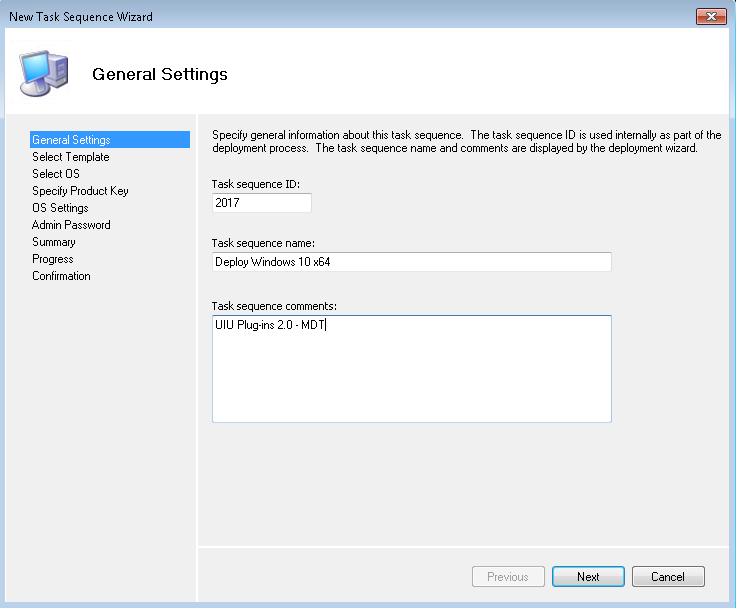
Click “Next” to continue
Select Standard Client Task Sequence
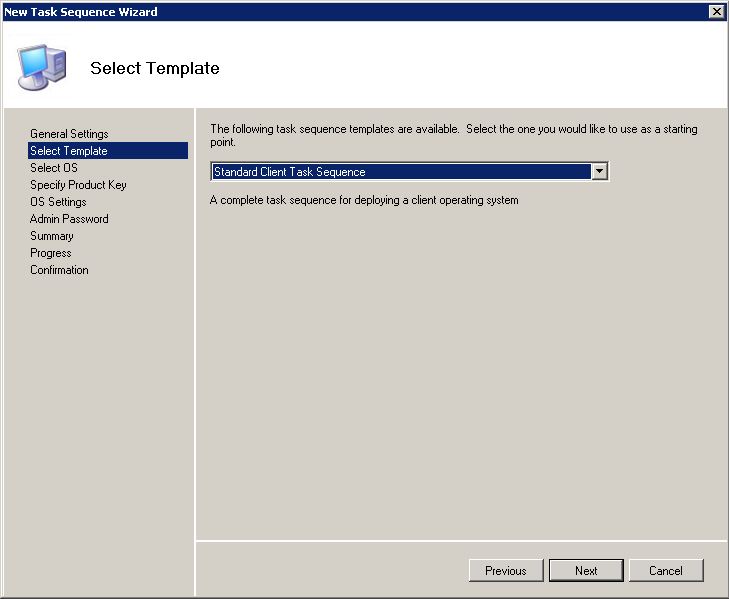
Click “Next” to continue
Select an OS to deploy
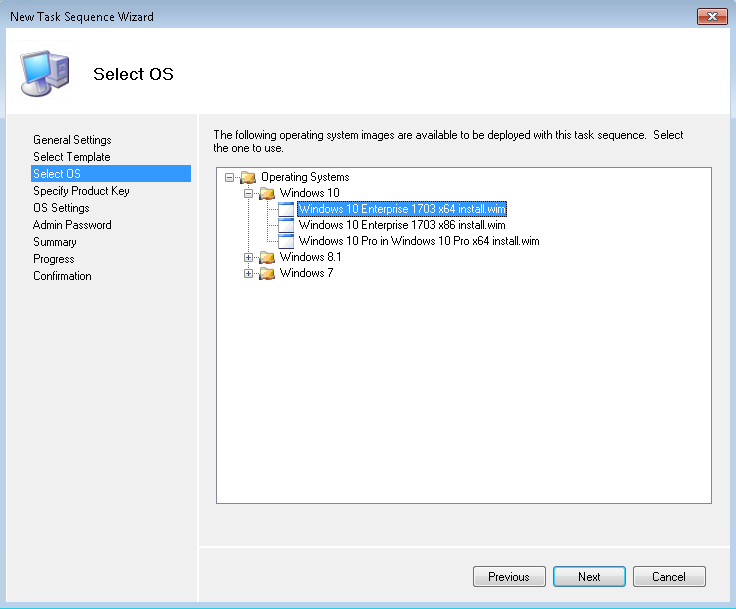
Click “Next” to continue
Specify a Product Key (if desired)

Click “Next” to continue
Configure OS Settings
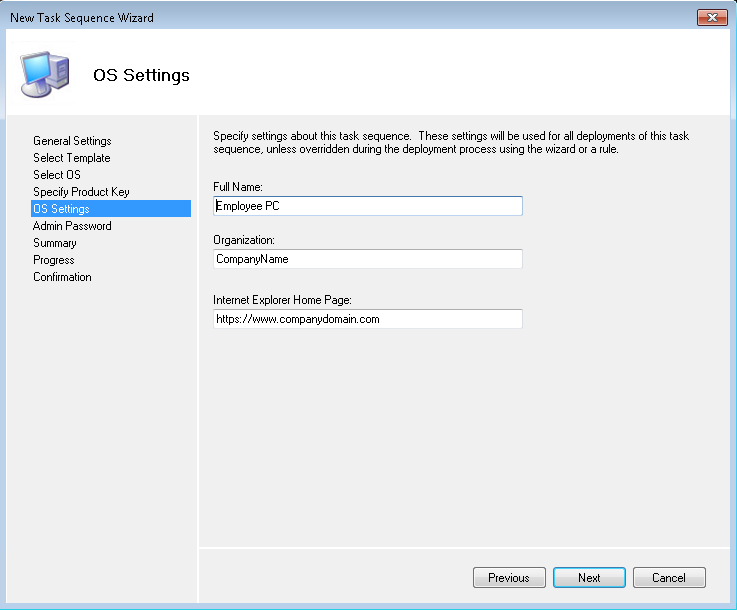
Click “Next” to continue
Provide Administrator password (if desired)

Click “Next” to continue
Complete the Wizard
- Disable MDT's driver injection feature
Disable the "Inject Drivers" task element

———
- Add the UIU Plug-ins 2.0 element/UIU Deployment Configuration
Add the UIU Deployment Configuration task sequence element
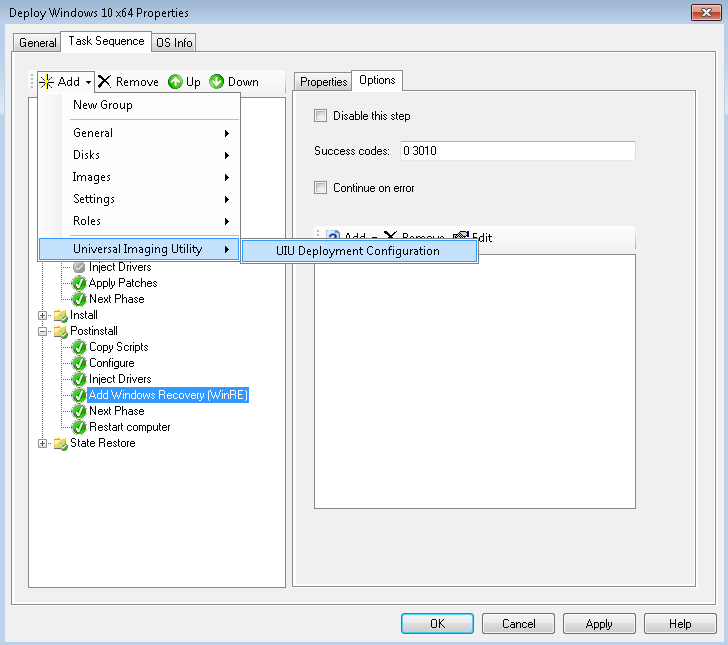
———
The UIU task element should be located

Directly before "Next Phase" in the Postinstall section
- Configure UIU Deployment Settings
The settings in the UIU Deployment Configuration task element must be completed before closing the task sequence. The UIU Deployment Configuration step may not be included in the saved task sequence if it is not properly configured.
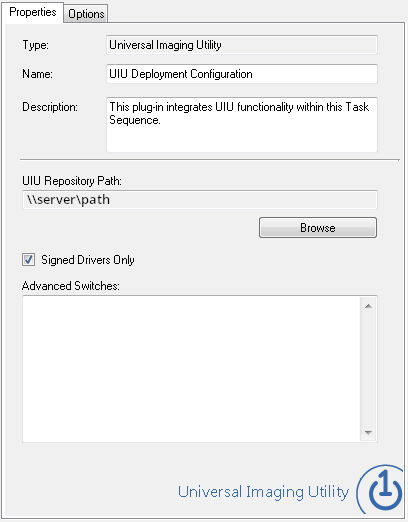
- Designate the pre-established UIU Repository path by selecting the "Browse" button and navigating to the location.
- Select "Signed Drivers Only" to instruct the UIU to only copy drivers that have been digitally signed specifically by their OEM. No unsigned drivers will be presented to the target machine.
- Specify "Advanced Switches" as required. Refer to the previous section on UIU Plug-ins 2.0 Command Line Arguments.
When all configurations are completed, select "OK" in the Deployment Settings window and then select "Apply" in the task sequence editor in order for the UIU Configuration Settings to take effect.
"Apply" must be selected in the task sequence editor in order for the UIU Configuration Settings to take effect!
If you've made any changes that affect the boot image, including adding storage (HDC) drivers or network drivers, you'll need to update the MDT Deployment Share. Please refer to the following site link details:
Update the MDT Deployment Share: When Why and How
- Deploy UIU for MDT to Target Machines
Boot target machines via PXE or using the created MDT LiteTouch ISO on a bootable DVD
Complete the MDT wizard on the booted target machines; be sure to select the task sequence that contains the UIU Deployment Configuration task element.
Deploy your UIU-prepared Windows operating system.

Section 6: UIU Plug-ins 2.0 Off-Network (Offline Media) Procedure for MDT
UIU for MDT Off-Network (Offline Media) Procedure
For Target Machines not connected to a network
In deployment instances where it is desirable or necessary to deploy an operating system while not connected to a network or when PXE services are not available, MDT (similar to SCCM) provides a method to produce media to be used off-network, (also referred to as Offline Media). The following procedure will assist in creating effective off-network media (USB preferred due to aggregate package sizes) including the use of the UIU plug-in for MDT:
- The configured MDT environment must have ability to deploy images without UIU (prerequisite).
- If not already installed, install UIU plug-in for MDT on same PC as Deployment Workbench
- If not already installed, Install UIU plug-in for MDT using directions from UIU plug-in for MDT Install Guide
- Create new application, selecting an appropriate name, (e.g. “UIUForMDT”):
- Navigate to Deployment Workbench > Deployment Shares > [Deployment Share name] > Applications and create a new folder called "UIUforMDT" (or the like) for the purposes of inclusion into a Selection Profile (Step 4.b.i).
- Navigate to Deployment Workbench > Deployment Shares > [Deployment Share name] > Applications > UIUforMDT folder and right-click "New Application".
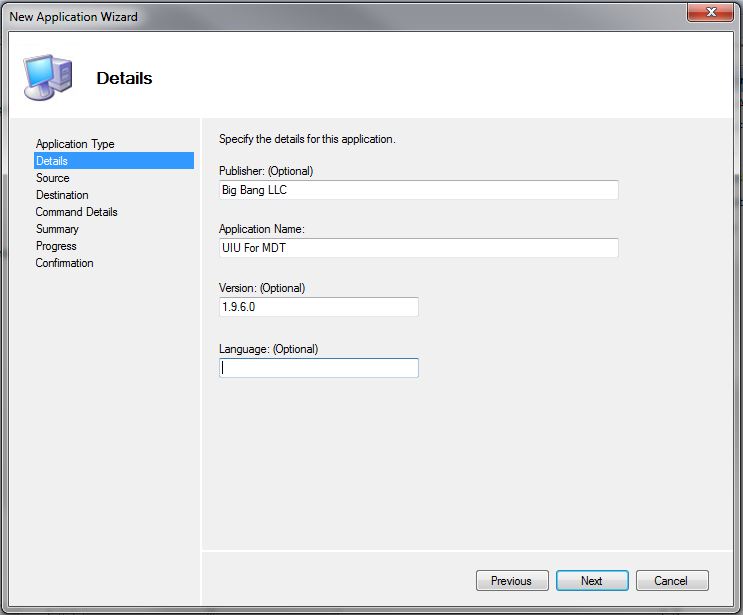
- During the create application wizard, select “Application with Source Files”; and in the "Source" step, browse to the shared location of the UIU Repository which was established initially with the UIU Plug-in Manager (UIUPM), annotated in Repository Management. The application should include the amd64, x86, components, and repository folders. This creates an MDT-compatible application package with the UIU Driver Database fully extracted and ready for use.

- In the Destination field, give a name for the application, (eg. “UIUForMDT”). This will dictate the physical folder name in the Deployment Share.
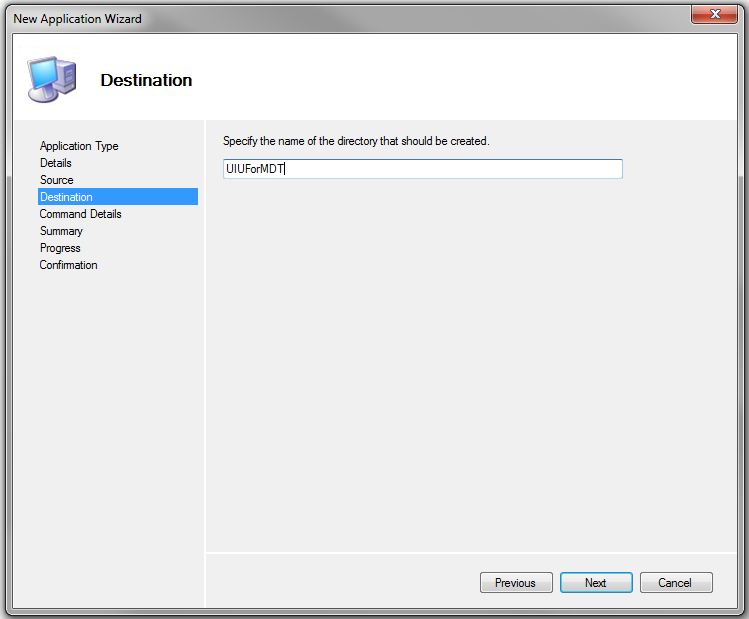
- In Command Details, a command line argument is required by the MDT wizard, (even though it is not used in this context). Supply a null or “dummy” executable such as “notepad.exe”. NOTE: This application will not actually ever be launched via the MDT Application Installer! (This is a requirement for the MDT wizard only)
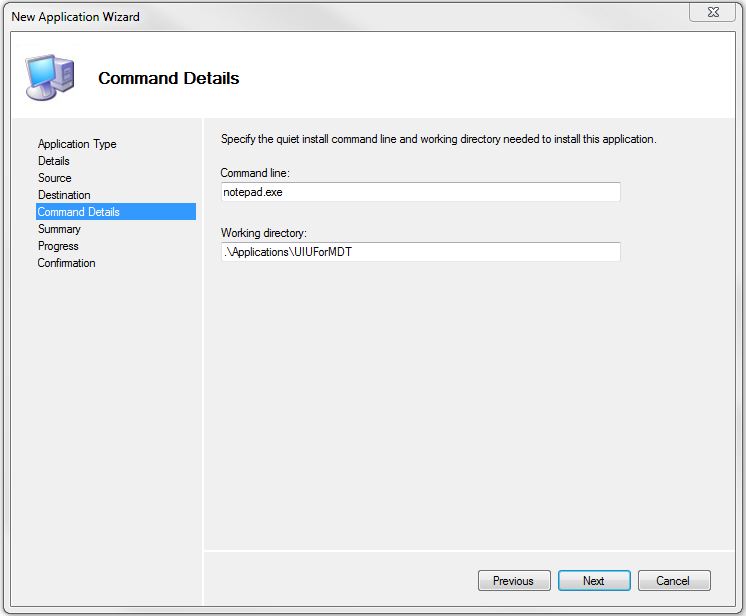
- Finish the New Application wizard.
- Add the UIU Deployment Configuration step to the desired offline deployment task sequence. (Refer to the UIU plug-in for MDT User Guide)
- Change the Network Path [UNC] parameter in Configure Deployment Settings to the following:
%deployroot%\applications\[UIUForMDT]
([UIUForMDT] should match the application name as entered in step 2.b.iv
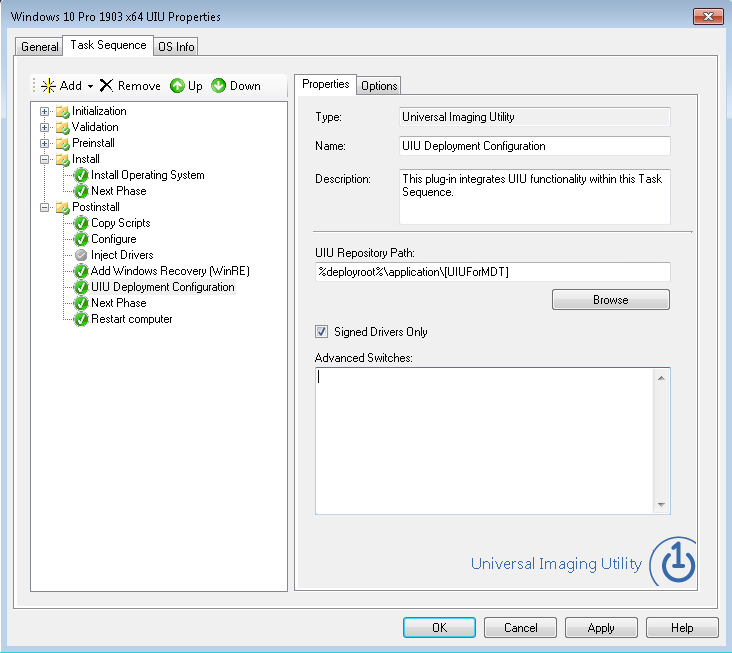
- Creating off network media
- If Deployment Share has multiple operating systems, applications, or packages, now is the time to create additional folders for other components so that an optimized (slim) offline Selection Profile can be created. Copy appropriate content from the Deployment Share to each folder created as desired. These folders may be selected individually to exclude unwanted applications from being copied to the off-network media.
- Under Advanced Configuration > Selection Profiles, create a New Selection Profile choosing only the Applications and Operating Systems that are desired for the particular off-network deployment.
- NOTE: Selecting more than what is necessary will result in larger than necessary ISO files or USB storage requirements.
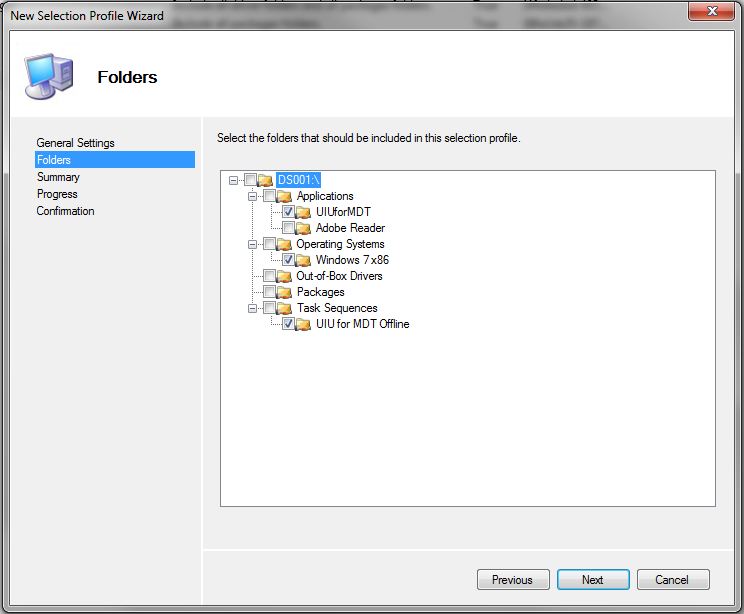
- Once the Selection Profile has been created, right-click on Advanced Configuration > Media and Create New Media using the selection profile desired. Record the Media path that you designate in this wizard for later use.

- Format USB drive (recommended) using Diskpart.exe. This USB drive should be large enough to hold the entire media as defined by the Selection Profile used. (As a point of note, the inclusion of an OS, UIU for MDT and the off-network task sequence “bare bones configuration” is approximately at least 20 Gb in size.)
- On a computer running the Windows operating system, insert the USB drive.
- From a command prompt, run Diskpart.exe
- Execute the command “list disk” to determine the disk number associated with the device.
- Input the following commands, where N is the disk number identified in the previous step:
- select disk N
- clean
- create partition primary
- select partition 1
- active
- format fs=fat32 quick -or- format fs=ntfs quick
- assign
- exit
Diskpart.exe is a powerful utility and can cause damage to your system. Make sure to format the correct drive!
Note: UEFI partitions, by design, will only boot with drives that have been formatted with fat32. Fat32 partitions cannot exceed 32Gb in total size and cannot contain individual files larger than 4Gb.
- After media has been created there will be a “Content” folder in the Media path that was chosen in step 4.c. Copy the contents of the Content folder to your freshly formatted USB.
- Test the bootable USB containing the off-network media for desired results before implementing the process in a production environment.

Section 7: Deployment
What will I see on my target machines?
Boot into WINPE
Launch an OS Deployment Task Sequence containing the UIU Plug-ins 2.0
Observe the typical Install Task Sequence steps through “Apply Operating System”
As the Microsoft Client executes the “UIU Deployment Configuration” task, settings selected in the UIU configuration are initialized and UIUPrep is executed.
The UIUPrep application performs the bulk of the work for the UIU
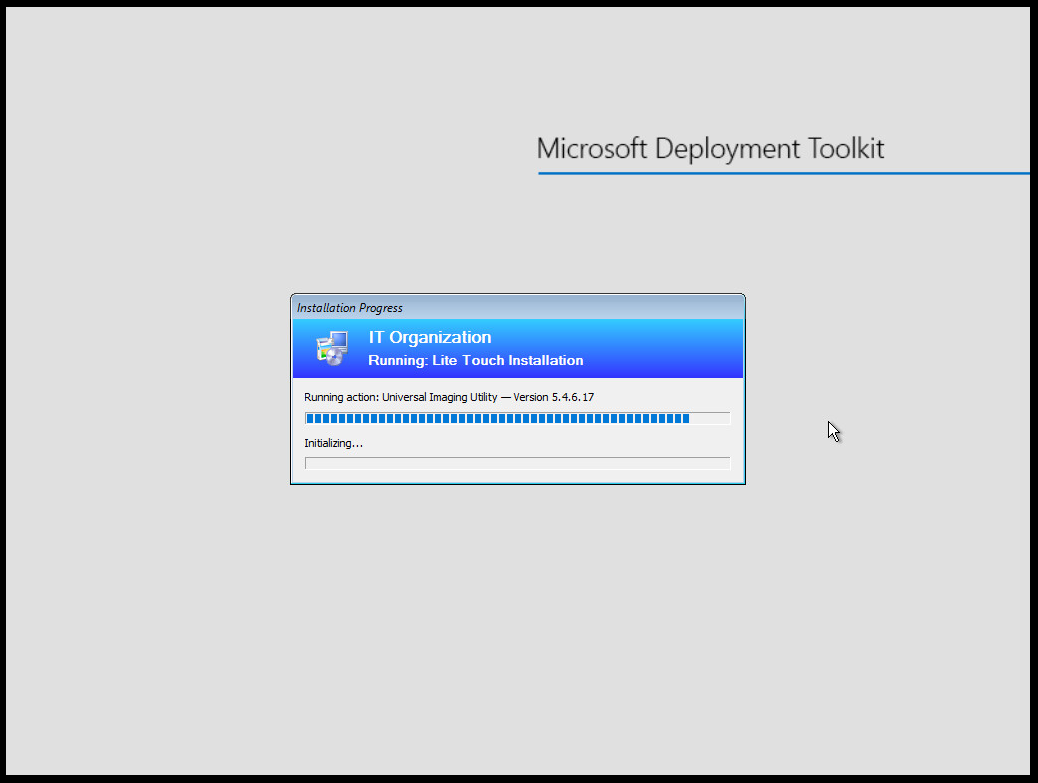 ———
———
After initialization, the UIUPrep application performs the following steps:
- Copies all necessary executables and supporting files to the target machine.
- Analyzes all hardware components on the target machine for applicable Hardware IDs.
- Identifies all required UIU drivers as analyzed in the previous step and copies only the required driver files to the target machine.
- Applies proprietary technology to ensure that a complete driver set is provided to the target machine.
- Removes existing driver components in order to allow Microsoft’s driver enumeration method to function efficiently.
- Installs the copied drivers into the Local Driver Store to be presented to (and enumerated by) Microsoft mini-setup.
Upon completion, UIUPREP will initiate a restart of the target machine and invoke Microsoft mini-setup to perform Sysprep-related functions and driver enumeration.
After which, the UIU releases control to the Task Sequence for completion of any tasks that followed the “UIU Deployment Configuration” task.
The target machine operating system setup is complete and login may be initiated.

Section 8: The UIU TRIAL Version
Trial versions of the UIU Plug-ins 2.0 may obtain driver and executable updates from Online Updates until the UIU Trial License key expires.
Trial versions of the UIU Plug-ins 2.0 may
shut down the operating system of target machines where trial images are deployed. Notification or warnings may be displayed on target machines after deployment in the form of a notice during login (credential provider) and by the inclusion of a stylized background screen. The Trial Background is not included in the licensed version of the UIU.
It is imperative that no TRIAL UIU-prepared image be deployed to any production PC. The TRIAL UIU product is intended for evaluation use only in pre-production or testing environments only.

Section 9: Updating the UIU Plug-ins 2.0
Please review
Section 8 (Tour of the UIU Plug-in Manager) of the UIU Plug-ins 2.0 - MDT Install Guide for specifics on updating a UIU License key, updating the UIU Plug-in Manager (UIUPM) application, and
updating the UIU plug-in components and driver database/files.
Scripting UIU Online Updates
Command Line Options are available to allow for the scripting of UIU components, driver database version and driver files (based on driver database version). These updates may be scripted using a batch file or Microsoft Scheduled Tasks, etc.
Referring to the UIU Plug-in Manager application, in the Repository Management section, the
Script Updates button will provide a sample command line based on the machine that the UIUPM is executed on. This assumes that a valid UIU License Key has been applied and that an appropriate UIU Repository UNC path has been established and provided.
If the scripted updates are to be executed from a machine on which the UIU Plug-in Manager application has not been or will not be executed, additional steps must be taken to focus the UIUPM at the appropriate location.
First, the machine that will initiate the scripted UIU Online Updates, the Admin Machine, must be informed as to the location of the UIU Repository to where the updates will be applied, using the following command:
"\\server\path\uiupm.exe" -CHANGEREPOSITORY "\\server\<UIU Repository UNC path>" domain\AdminUser Password
Next the Admin Machine must be informed of the valid UIU License Key required to obtain UIU Online Updates successfully, using the following command:
"\\server\path\uiupm.exe" -licensekey "XXXXXXXXXX-!v4!CompanyName-XXXXXXXX"
Note that the UIU License Key may be applied in the same command line as the actual update parameters. It is represented individually for the use case wherein License Keys are protected and not made available/obvious to non-Administrators.
Alternative Example:
"\\server\path\uiupm.exe" -licensekey "XXXXXXXXXX-!v4!CompanyName-XXXXXXXX" -UPDATE COMPONENTS DATABASE DRIVERFILES CLEANUP
Once the Admin Machine is aware of the location of the UIU Repository to be affected and of the UIU License Key, UIU Online Updates may be initiated using the following command:
"\\server\path\uiupm.exe" -UPDATE COMPONENTS DATABASE DRIVERFILES
- DATABASE refers to the version of the UIU Driver Database (UDB)
- DRIVERFILES refers to the individual driver files that are relevant to the version of the DATABASE
- COMPONENTS refers to UIU executables, namely UIUPREP.EXE (x86 & x64)
- CRC refers to the validation of each Driver File during download
- CLEANUP refers to the removal of driver files that are not represented in any of the available DATABASE versions (UDBs)
For additional details, please refer to
Section 8 (Tour of the UIU Plug-in Manager) of the UIU Plug-ins 2.0 - MDT Install Guide.
As environments and implementations may vary drastically, please contact UIU Support with any questions regarding the optimal implementation of UIU Plug-ins 2.0 scripted Online Updates.
Updating the UIU License Key in UIU Plug-ins 2.0 for MDT
- Launch the UIU Plug-in Manager (UIUPM.exe).
- Select Licensing from the Main menu.
UIU Plug-in Manager application - Licensing

–––
- Enter the new UIU License Key.
UIU Plug-in Manager application - Licensing
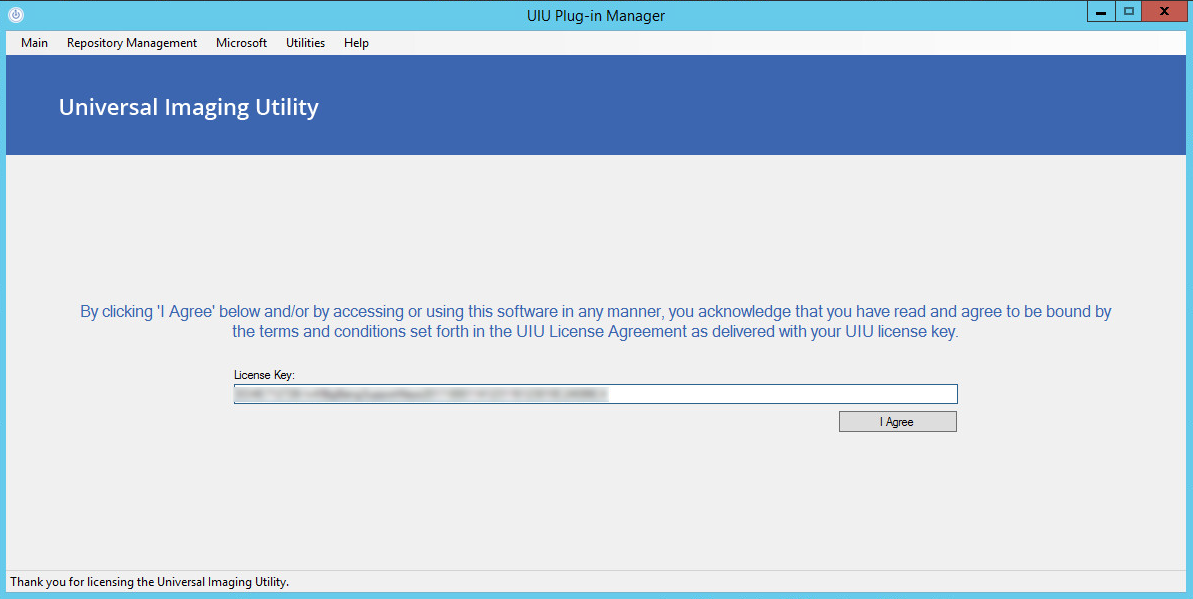
Select “I Agree”
- Ensure that there are no instances of the Deplyment Workbench running on the system and Select "Microsoft Deployment Toolkit" from the Microsoft menu.
UIU Plug-in Manager application - Microsoft menu

–––
- Select “Update Plug-in”
UIU Plug-in Manager application - Microsoft Deployment Toolkit
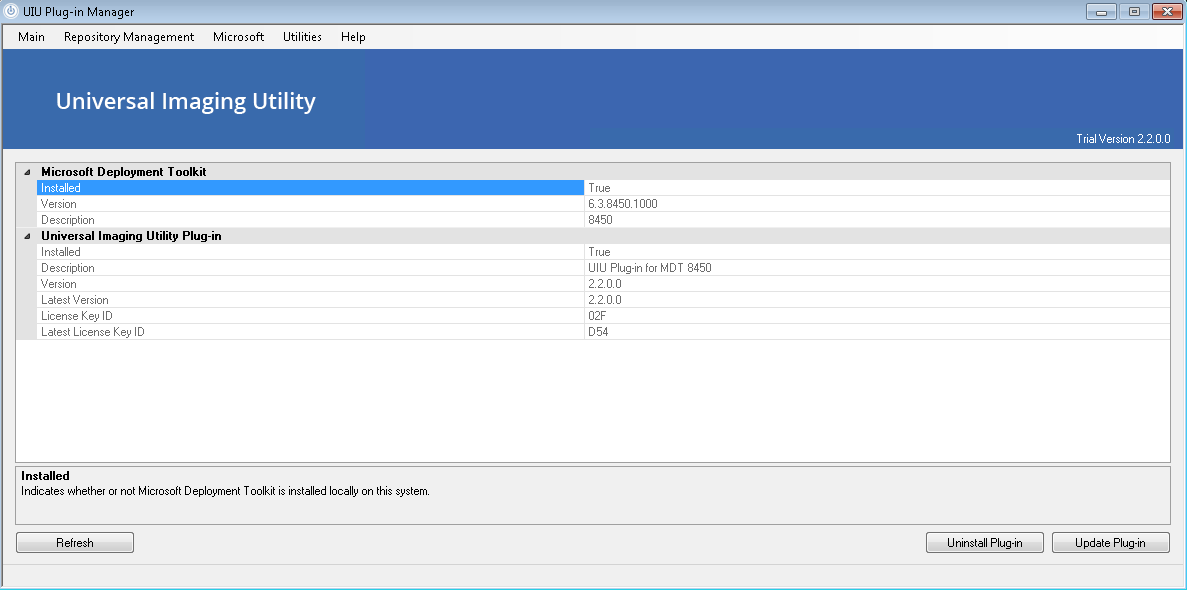
–––
Note: As of version 2.3.1.0 of the UIU plug-ins for MDT, it is no longer necessary to trigger an apply event in each UIU-integrated task sequence in order to update the UIU license key in the corresponding task sequence elements. When the UIU plug-in for MDT is updated using the UIU Plug-in Manager application, the UIU-integrated task sequences are automatically updated with the UIU license key that had been registered with the application at that time.
In the instance where the UIU is executed via Run Command within a Task Sequence, the expired UIU License Key must be replaced with the new UIU License Key.
Even in the instance where the plug-in has not been integrated, be sure to also update the license key in the Plug-in Manager.

Offline Updates
The required files are listed below:
The following instructions apply to both SCCM and MDT, as both plug-ins are managed by the same components within the UIU Plug-in Manager (UIUPM).
To update the UIU Plug-in Manager (UIUPM)
- Download from the first link above, extract UIUPM.exe, and replace your existing instance of UIUPM.exe with this file.
- The UIUPM is not installed and is a standalone application. Its configuration is saved and will connect to any new instance of UIUPM.exe when executed from the same PC.
- After replacing UIUPM.exe, simply launch the UIUPM to continue managing your UIU Repository and UIU Plug-ins.
To update UIU Program Files (in this particular case, UIUPrep)
- Download from the second link above, and extract the IMP file contained therein (in this case, p5600.imp).
- Launch the UIUPM and select the Repository Management screen from the main menu.
- Ensure that the repository path selected (above) is the desired recipient of the imported database.
- Click on the Import Repository button.
- Navigate to your extracted IMP file, and select Open.
- The UIUPM console will flash briefly (very small file(s)), and your UIU Program Files have successfully updated.
Important note:
Everything below “Repository Update Options” on the right-hand side of the screen applies to online updates only.
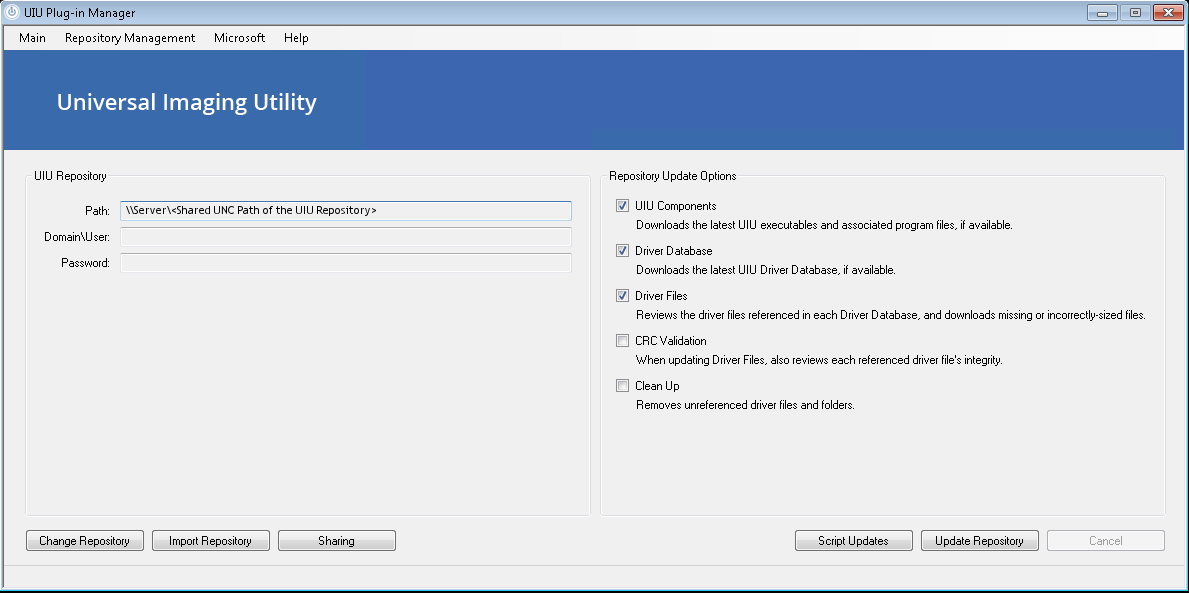 For import functions (i.e. offline updates), please leave these settings at the default configuration.
For import functions (i.e. offline updates), please leave these settings at the default configuration.
To update UIU Driver Database (not applicable here, but it will be shortly, so I’ve included it)
- Download from custom link delivered by Big Bang, and extract the IMP file contained therein.
- Launch the UIUPM and select the Repository Management screen from the main menu.
- Ensure that the repository path selected (above) is the desired recipient of the imported database.
- Click on the Import Repository button.
- Navigate to your extracted IMP file, and select Open.
- Import progress will be noted in the lower left bar of the UIUPM.

Section 10: UIU Discovery Tool – UIUDT
The
UIU Discovery Tool (UIUDT) is designed to analyze machines in your environment to determine their compatibility with the UIU Driver Database.
When using the UIUDT to either pre-determine if drivers will be missing, (potentially leading to blue-screen BSOD errors) or when experiencing driver “bangs”, please notify UIU Support immediately by submitting the results file to
UIU Support. Thank you!
How do I get the UIUDT?
The new UIU Discovery Tool v2.0 may be downloaded from
UIU Support Tools Download.
How do I run the UIUDT?
ALERT: The UIUDT process has changed! Please refer to the
UIUDT v2.0 Instructions before attempting to execute the new UIUDT.

Section 11: Technical Support
As part of the licensing agreement with Big Bang LLC, technical support for the Universal Imaging Utility (UIU) is available for one year from the original purchase date. Big Bang LLC technical support can be reached through the following methods:
On Line Support Form (Preferred):
UIU Support
Direct Telephone Support: 414-369-5020
(M-F 9:00am-5:00pm Central:GMT-6)
Email Support: support@bigbangllc.com
Send UIU Support an email
When contacting support, please be ready to provide the following information:
The MDT system must be tested and proven capable of deploying a supported Windows operating system independently, (without the UIU plug-in for MDT software.)
Version of the UIU plug-in
Revision of the Driver Database (including Custom Driver Packages, and any MDT Driver Packages)
UIU License Key
Version of MDT
Version of Windows Server OS including Service Pack
Process used to create an operating system image used in the Install Task Sequence, (Build & Capture, DISM\ImageX Capture, etc.)
PC Operating System and Service Pack
PC Make/Model of Recipient (deployed to) machine(s)
UIU log file (C:\Programdata\UIU\UIU.log)
Nature of the Problem; Blue Screen, Continual Reboot, Missing Hardware Driver, etc.
In situations relating to UIU Plug-in for MDT failures, please be able to provide the following files from the MDT server:
UIU Plug-in log file (C:\ProgramData\UIU\UIUPM.log)
In situations relating to missing or incorrect hardware drivers, please be able to provide the following files from the Recipient Machine:
Windows 7, 8.1 and 10 (32-bit or 64-bit)
UIU log file (C:\ProgramData\UIU\UIU.log) ~ hidden directory by default
SETUPAPI Log (C:\windows\inf\setupapi.dev.log)
SETUPAPI Setup Log (C:\windows\inf\setupapi.setup.log) -- Windows 8.1 & 10 only
NOTE: Technical Support and Updates are only available for operating systems and hardware currently supported by the UIU. Please see the section titled “Section 1: Requirements and Limitations” for more details.
Please review this User Guide
before employing
the Universal Imaging Utility Plug-ins 2.0 with MDT.
